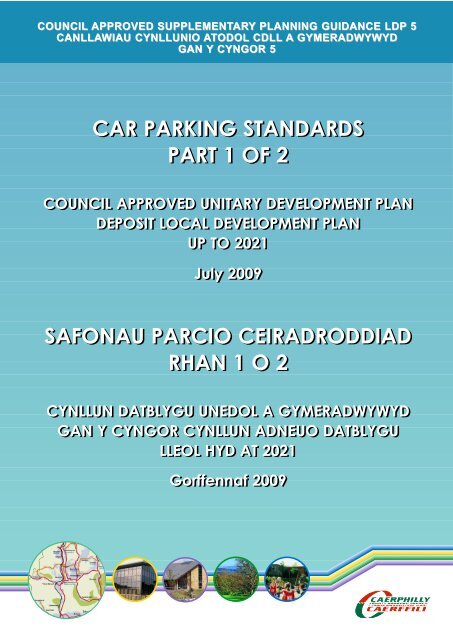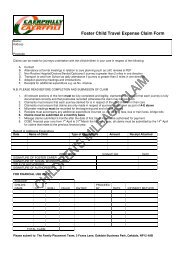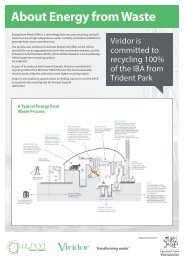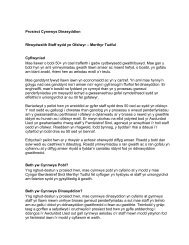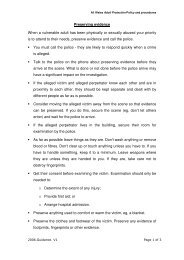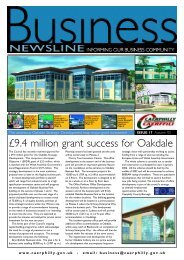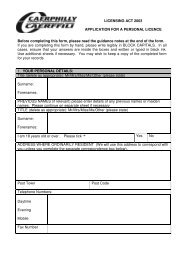CAR PARKING STANDARDS PART 1 OF 2 SAFONAU PARCIO ...
CAR PARKING STANDARDS PART 1 OF 2 SAFONAU PARCIO ...
CAR PARKING STANDARDS PART 1 OF 2 SAFONAU PARCIO ...
You also want an ePaper? Increase the reach of your titles
YUMPU automatically turns print PDFs into web optimized ePapers that Google loves.
COUNCIL APPROVED SUPPLEMENTARARY PLANNING GUIDANCE LDP 5CANLLAWIAU CYNLLUNIO ATODOLCDLL A GYMERADWYWYDGAN Y CYNGOR 5<strong>CAR</strong> <strong>PARKING</strong> <strong>STANDARDS</strong><strong>PART</strong> 1 <strong>OF</strong> 2COUNCIL APPROVED UNITARY DEVELOPMENT PLANDEPOSIT LOCAL DEVELOPMENT PLANUP TO 2021July 2009<strong>SAFONAU</strong> <strong>PARCIO</strong> CEIRADRODDIADRHAN 1 O 2CYNLLUN DATBLYGU UNEDOL A GYMERADWYWYDGAN Y CYNGOR CYNLLUN ADNEUO DATBLYGULLEOL HYD AT 2021Gorffennaf 2009
Council Approved Unitary Development PlanDeposit Local Development Plan:Supplementary Planning Guidance –Car Parking StandardsLDP 5Parking Standards approvedJuly 2009
Supplementary Planning GuidanceLDP5 – Car Parking StandardsCONTENTSPage1. Introduction...............................................................................12. The Need For Parking Standards SPG ....................................13. Parking Zone Designation ........................................................24. Application of the Parking Standards .......................................2Appendix 1........................................................................................3A1 Preamble 5A2 Purpose 5A3 Application 5A4 Strategic Framework 5A5 Parking Zones 7A6 Application Of Parking Standards 9A7 Definitions And Notes 11A8 General Statement 14A9 Parking Standards By Land Use 15Residential : New Build & Conversions Zone 1 ...........................................15Offices, Use Class B1 Busimess, Class A2 financial& ProfessionalServices (Including Call Centres) ................................................................17Shops (Including Shops, Supermarkets & Superstores) Zone 1 ..................18Retail Warehousing And Garages Zones 2 to 5 ...........................................20Industry And Industrial Warehousing Zone 1................................................22Places Of Entertainment Zone 1 ..................................................................24Hotels And Restaurants Zone 1 ...................................................................26Community Establishments Zone 1..............................................................29Educational Establishments Zone 1 .............................................................31Schedule 1 Access For The Disabled,Guidance Notes For Applicants 34Schedule 2 Layout Of Parking Areas 36Schedule 3 Landscaping 38Schedule 4 Cycle Parking Standards 39Schedule 5 Motorcycle Parking Standards 42Schedule 6 Sustainability 43BIBLIOGRAPHY ........................................................................................45July 2009
Supplementary Planning GuidanceLDP5 – Car Parking Standards1. Introduction1.1 The application of parking standards enables a transparent and consistentapproach to the provision of parking facilities associated with new development andchange of use. This Supplementary Planning Guidance (SPG) identifies how theCSS Wales – Wales Parking Standards 2008 will be applied across Caerphillycounty borough.1.2 This guidance supplements policy DC1 of the Approved Caerphilly County BoroughUnitary Development Plan and policy SP24 of the Caerphilly County BoroughDeposit Local Development Plan.1.3 LDP 5 was reported to Regeneration Scrutiny on 7 th July 2009, Cabinet July 21 st2009 and Full Council on July 28 th 2009 where it was approved as SupplementaryPlanning Guidance. LDP 5, Car Parking Standards: Parking Zones supersedes‘Standing Conference Guidelines on Parking’ and ‘Development Design Guide13: Car Parking Standards’2. The Need For Parking Standards SPG2.1 Through this SPG, Caerphilly County Borough Council will adopt the CSS Wales –Wales Parking Standards 2008 (Appendix 1). The document provides detailedparking requirements according to land use and type of development. Thestandards cover all built up and rural areas. The Wales Parking Standards 2008replaces the previous standards used by this Council – South Wales ParkingGuidelines Revised Edition 1993.2.2 The parking requirements outlined in the Wales Parking Standards 2008 documentshould be interpreted as maximum standards i.e. ‘not more than’ figures. (It shouldbe noted that the use of the term maximum has been avoided by the document, asit is capable of misinterpretation by developers.)2.3 The Wales Parking Standards 2008 makes it be possible for the level of parkingrequired by a development to be reduced as a result of the sustainability of adevelopment. The application of the sustainability criteria outlined in Appendix 6 ofthe Wales Parking Standards 2008 can lead to a reduction in the level of parkingrequired by a development. The criteria measure the sustainability of a developmentin terms of walking distance to local facilities, public transport and cycles routes andthe frequency of local public transport services.2.4 The standards outline the types of development that will require a travel plan as acondition of planning consent. The travel plan may subsequently result in arelaxation of parking requirements. It should be noted that travel plans might also berequired for other types of development that are unable to meet the parkingrequirements.2.5 The Wales Parking Standards 2008 includes the requirement that Local Authoritiesintroduce a system of zones for parking purposes into Local Development Plans.The Wales Parking Standards 2008 identifies six such zones, each with differingdesignated levels of parking requirement for development control purposes. Thestandards state that it is the responsibility of individual local authorities to decidewhich of the zones are applicable to their local authority area and where the zoneboundaries should be drawn within their area.July 2009 1
Supplementary Planning GuidanceLDP5 – Car Parking Standards2.6 This SPG document sets out the parking zones within Caerphilly county borough.3. Parking Zone Designation3.1 The Wales Parking Standards 2008 defines six parking zones, which are numberedas Zones 1 to 6. The distinction between each of the zones is largely based onvarying levels of accessibility to services and facilities. The zone descriptions, andtherefore parking requirements, range from Zone 1, which is applicable only to citycentres with very high levels of accessibility to all services, to Zone 6, which isapplicable to rural, countryside locations with low levels of accessibility.3.2 The designation of the parking zones in Caerphilly county borough has been basedon the zonal descriptions contained within the Wales Parking Standards 2008. Assuch, the parking zones within Caerphilly county borough have been determinedthrough a judgement of each area in terms of:a) The number, range and characteristics of the facilities within walkingdistance;b) The level of public transport provision and particularly the number andfrequency of bus services available.3.3 It should be noted that no areas within Caerphilly county borough have beendefined as Zone 1, as this zone requires very high levels of accessibility that ischaracteristic of city centres such as Cardiff. The areas that are covered by the fiveparking zones applicable to Caerphilly county borough are shown on the planswithin this document. The zones are numbered as Zones 2 to 6 for ease ofreference, in line with the Wales Parking Standards 2008.3.4 It should also be noted that: The LDP settlement and town centre boundaries were used when definingzones. All areas designated as Zones 2 to 5 lay within LDP settlementboundaries. All areas lying outside the LDP settlement boundaries have been designatedas Zone 6, due to the rural characteristics of such areas.4. Application of the Parking Standards4.1 The parking zone plans contained within this document will be used in conjunctionwith the Wales Parking Standards 2008 (Appendix 1) and the sustainability criteriacontained within that document, to assess the parking requirements for all futuredevelopment in Caerphilly county borough.July 2009 2
Supplementary Planning Guidance - Appendix 1Parking StandardsAppendix 1Wales Parking Standards 2008Produced on behalf of the County Surveyors’ Society Wales,Development Control ForumsCSS WalesCSS CymruJuly 2009 3
Supplementary Planning Guidance - Appendix 1Parking StandardsJuly 2009 4
Supplementary Planning Guidance - Appendix 1Parking StandardsA1 PreambleA1.1 These Parking Standards should be read in conjunction with individual RegionalTransport Plans, Local Transport Plans, Unitary Development Plans, LocalDevelopment Plans and Supplementary Planning Guidance. Parking requirementsare listed according to land use and location and they list requirements forcommercial vehicles, cars, motor cycles and cycles. The use of travel plans and thesustainability of new development are also addressed. The Parking Standards willbe material to decisions on individual planning applications and will be used as atechnical reference document.A2PurposeA2.1 These Parking Standards seek to ensure a transparent and consistent approach to theprovision of parking, submission of travel plans and sustainability considerations that willinform developers, designers and builders what is expected of them and from them at anearly stage of the development process.A3ApplicationA3.1 These Parking Standards will inform observations made by Highway Authorities onapplications received for Planning Permission.A4Strategic FrameworkA4.1 This document provides detailed parking requirements according to land use and type ofdevelopment. It has been prepared by CSS Wales on behalf of all 22 Welsh UnitaryAuthorities and the four regional transport consortia, Sewta, SWWITCH, Taith and TraCC.Its aim is:a) To assist developers, designers and builders in the preparation and submission ofplanning applications.b) To achieve a common approach to the provision of vehicle parking facilitiesassociated with new development and change of use.A4.2 The underlying rationale for the South Wales Parking Guidelines Revised Edition of 1993prepared by the Standing Conference on Regional Policy and the correspondingdocumentation relating to North Wales was to provide sufficient parking to avoid the needfor vehicles to park on-street and thereby cause congestion, danger and visual intrusion.A4.3 Since 1993, fundamental changes in national planning framework and transport policy havetaken place with the publication of PPG 13 (in England) in 1994, the Environment Act 1995,the Road Traffic Reduction Acts 1997 and 1998, A New Deal for Transport: Better forEveryone and Transporting Wales into the Future (1998), Planning Policy Wales in 2002,Planning Policy Wales Technical Advice Note 18 (TAN 18) in 2007 and Manual for Streetsin 2007. In particular, paragraph 8.4.2 of Planning Policy Wales 2002 states that ‘CarParking Provision is a major influence on the choice of means of transport and the patternof development. Local authorities should ensure that new developments provide lowerlevels of parking than have generally been achieved in the past. Minimum parkingstandards are no longer appropriate. Local authorities should develop an integratedstrategy on parking to support the overall transport and locational policies of the UDP.’ TAN18 supplements Planning Policy Wales and states that ‘Maximum car parking standardsshould be used at regional and local level as a form of demand management’ and, that fornew development, regard should be given to alternative transport modes, economicobjectives, public and shared parking arrangements.July 2009 5
Supplementary Planning Guidance - Appendix 1Parking StandardsA6Application Of Parking StandardsA6.1 The scale of parking provision varies throughout Wales and local priorities will dictate themanner in which the standards are used. Interpretation and application of the standards willrest with the Local Authority, but flexibility in the standards allows local circumstances to betaken into account. It is expected that the preparation of Regional Transport Plans, LocalDevelopment Plans, the designation of Conservation Areas, Housing Action Areas, GeneralImprovement Areas, etc. will all impact on the interpretation of this document.A6.2 In assessing the parking requirements for a particular development, the planning authoritywill need to take into account a number of factors in relation to the development and itslocation. These are listed below. However it should be noted that some of these factors areoutside direct planning control, e.g.:(a) Accessibility to and the service provided by the public transport system,(b) The availability of private buses or the extent of car pooling,(c) The relative proportions of full time / part time / local catchment of labour,(d) Accessibility by walking and cycling,(e) The existing and possible future congestion in streets adjacent to the development,(f) Accessibility to and the availability of public and/or private car parking space in thevicinity.A6.3 This Standard covers all built up and rural areas. The full operational standard will normallybe expected together with the non-operational standard for employees’ vehicles and incertain cases for visitors. Normally developers will be required to provide all the parkingspace within the curtilage of the site.A6.4 Section 106 Agreements may be negotiated with developers and these can include anumber of measures to mitigate the potential impact of development and to addressconcerns.A6.5 All parking areas other than residential parking areas off low-trafficked, low speed, minorresidential roads should be designed to allow vehicles to enter and leave the site in forwardgear.A6.6 Safe pedestrian access routes must be provided within all new car parks.A6.7 Travel plans will be required as a condition of planning consent for all developmentproposals of greater than 1000m 2 gross floor area and for smaller developments that willhave significant transport implications or will be sited where a reduction in vehicular trafficwould be particularly beneficial. Appropriate relaxation of the tabled parking requirementsmay be made following acceptance of the details of a submitted travel plan, alwaysprovided that measures to enforce compliance with the travel plan are included within aSection 106 Agreement. Suitable enforcement measures will include the provision oftargets, a monitoring regime and the appointment of a travel plan co-ordinator. BestPractice Guidance on the content and monitoring of travel plans is available in theDepartment for Transport documents “Using the Planning Process to Secure Travel Plans”,“Making Residential Travel Plans Work” and its associated “Good Practice Guidelines ForNew Development”.A6.8 In certain circumstances, e.g. Conservation Areas, modifications of the standards may beallowed in order to preserve environmental conditions.A6.9 Examples of the assessment of parking requirements using these Parking Standards aregiven on the next page.Examples of the Use of Parking StandardsJuly 2009 9
Supplementary Planning Guidance - Appendix 1Parking Standards(a) Proposed new shop and office development in a rural small local centre (Zone 5)Public transport accessibility is poor. The development comprises 500m² shopping (5 units)on the ground floor and 1000m² offices on the first and second floors. (Gross floor areaincluding external walls).The parking requirement is assessed as follows:-SHOPPING USEOperational Parking = Space for 2 commercial vehiclesNon Operational Parking 1 space / 20m² = 25 spaces<strong>OF</strong>FICE USENon Operational Parking 1 space / 25m² = 40 spacesTOTAL PROVISION:Space for 2 Commercial Vehicles + 65 spaces(b) Change of use from industry to non-food retail warehouse (mixed) (in Zone 2)Gross floor area 1500m² on an industrial estate.The operational requirement for industrial premises of 1500m 2 is (from note 5) 175m 2 ofyard space and 13 non-operational parking spaces (1 space / 120m 2 ).The requirement for retail warehousing is 3 commercial vehicle bays (225m 2 ) and 50spaces (1 space / 30m 2 ).Therefore, an additional operational area of 50m 2 should be provided so that a minimum ofthree commercial vehicles can be accommodated; plus an additional 37 parking spacesunless the site already has provision for 50 parked cars.(c)Conversion of a large 3-storey 5-bedroomed Victorian House to three onebedroomedFlats (in Zone 3)The parking requirement for the original house is three parking spaces, but given the age ofthe property, these may not actually be present.The parking requirement for the flats is 1 space per bedroom. Three parking spaces aretherefore required in theory. These should, if possible, be provided at the rear of thepremises. If the site has no existing parking, the conversion will not require any although itwould be desirable to gain these parking spaces. If the site is too small to accommodatethree cars and the house fronts a local road that is not a bus route and kerbside parkingpressure is not evident then an allowance of on-street parking immediately outside may bepossible. Local circumstances should always dictate the approach to be taken.July 2009 10
Supplementary Planning Guidance - Appendix 1Parking StandardsA7Definitions And NotesA7.1 Operational Parking Space - Sufficient space to allow the maximum number and size ofvehicles likely to serve the development at any one time and to manoeuvre with ease andstand for loading and unloading without inconvenience to vehicles and pedestrians on thepublic highway or to other users of the site.Space for staff cars that, by the nature of the business, is required for day to day operation,may also be included.A7.2 Non-Operational Parking Space - The space occupied by vehicles not necessarily usedfor the operation of the premises and it is divided into two classes:a) Long term (i.e. commuter parking) mainly occupied by vehicles ofstaff/clients/customers whose attendance at the premises are of long singledurations,b) Short term parking space required by staff/clients/customers whose attendances atthe premises are of short single durations.A7.3 Residential Parking Space - Includes space required for residents and space for cars ofpeople visiting the residents.A7.4 GROSS Floor Area - The standards that are related to floor areas are GROSS floor area,i.e. including external walls, except where the text stipulates otherwise in respect of publichouses, restaurants, cafes and places of worship.A7.5 Extension or Development of Existing Buildings – For industrial, office, commercialpremises and pre-1914 public houses, under 235m² gross floor area, an increase of 20%will be permitted without the need for additional parking. This allowance can only be madeonce and any parking displaced must be relocated.A7.6 Public Transport Accessibility – Public transport provision has the potential to reduceuse of the car and where appropriate the level of this provision should be enhanced asplanning gain through the planning process at the expense of developers. Ease of accessto public transport is related to required parking levels through the zoning systemintroduced by this document and through application of the sustainability considerationscontained within Appendix 6.A7.7 Employment Density - The standards have been assessed on density norms (retail19.5m 2 per employee; industrial 35 - 45m² employee, office 16.5m 2 per employee).Variations in density may be treated on their merits.A7.8 Land Use - for the purpose of applying the parking standards the following table outlinesthe land uses specified within the Town and Country Planning (Use Classes) Order 1987.July 2009 11
Supplementary Planning Guidance - Appendix 1Parking StandardsUSE CLASSES IN 1987 ORDERClass A1 : ShopsClass A2 : Financial & Professional ServicesClass A3: Food & DrinkClass B1 : BusinessClass B2 : General IndustrialClass B3 - B7 : Special IndustrialClass B8 : Storage or DistributionLAND USES IN <strong>PARKING</strong> GUIDELINESShopsSupermarkets and SuperstoresRetail Warehousing (Cash and Carry)Offices (only in cases where premises areprovided principally for visiting members of thepublic).Restaurants Public Houses Cafes TransportCafes Licensed ClubsOffices (other than in A2 above) / LightIndustryIndustryIndustryWholesale WarehousingClass C1 : Hotels & HostelsClass C2 : Residential InstitutionsClass-C3 : Dwelling housesClass D1 : Non-Residential InstitutionsClass D2 : Assembly and LeisureHotelsHomes for the Elderly, Children, etc.Nursing HomesHospitalsGeneral Purpose Houses & Flats ShelteredAccommodationHealth CentresSurgeriesChurchesPrimary Schools/Nursery SchoolsSecondary SchoolsColleges of Higher & Further EducationLibrariesAssembly Halls, e.g. Community Centres -Unlicensed ClubsLeisure CentresSports ClubsAssembly Hallse.g.. Bingo HallsNote Certain uses within this document do not fall within any specific Use Class andtherefore must be dealt with separately (see general uses) e.g. open air markets.The Standards have not been defined in terms of the 1987 Use Classes Order as thiswould lead to wide ranges of recommended provision, e.g. Class B1 businessencompasses some office uses and industry. A standard anticipating this interchangeabilitywould be very wide and therefore, standards are only given for specific landuse concerned e.g. office or industrial use.In view of the inter-changeability of uses it may be necessary to impose restrictions ondevelopment within these wider classes in order to reflect car-parking requirements.July 2009 12
Supplementary Planning Guidance - Appendix 1Parking StandardsJuly 2009 13
Supplementary Planning Guidance - Appendix 1Parking StandardsA8General StatementA8.1 The absence of parking standards for a particular land use does not mean that no parkingprovision will be required.A8.2 In addition the local authority reserves the right to treat all planning applications on theirmerits according to the size, nature, location, density, employment and traffic generationcharacteristics of the proposed development and its impact on the local and regionalhighway network.A8.3 The acceptance of a submitted travel plan by the local authority will always require thepreparation of a Section 106 Agreement to ensure continual compliance with the contentsof the travel plan.July 2009 14
Supplementary Planning Guidance - Appendix 1Parking StandardsA9Parking Standards By Land Usea) Residential : New Build & Conversions Zone 1Type of Development Residents VisitorsGeneral PurposeHouses and ApartmentsHouses 0.5 to 1 space per unit NilApartments 0.5 to 1 space per unit 1 space per 5 unitsHouse conversions to bedsits,or self-contained apartments0.5 to 1 space per unit NilSpecial Purpose HousingPurpose-built studentaccommodationSelf-contained elderly personsaccommodation (not wardened)Self-contained elderly personsaccommodation (wardened)1 space per 25 beds for servicing,wardens and drop-off areas.Nil1 space per 2 to 4 units Nil1 space per 4 units1 space for warden1 space per 2 ancillary staffNilNotes relating to Residential parking standards for all Zones1 Curtilage parking must be provided wherever possible. Where communal parking isprovided, it must be conveniently sited and should be in a location that is also overlookedwhich will thereby enhance its security. No parking court may accommodate more than 12parking spaces and depending on local context, designated parking secured by a lockablebollard or other means may be required. Safe pedestrian access must be provided betweeneach dwelling unit and its parking space.2. Garages should be provided as the most secure parking option wherever possible,preferably located alongside the dwelling. Remote garage blocks must be avoided.3. Garages may only be counted as parking spaces if they have clear internal dimensions, assuggested by Manual for Streets, for a single garage of 6m x 3m. If disabled access isrequired, these dimensions must be increased to 6m x 3.8m. All properties with a garagemust also have a 6m long driveway which has a width of not less than 3.6m.4. Visitor parking must be designed as an integral part of any development where it is requiredand must take into account the needs of the disabled.5. For developments where clear evidence has been supplied that car ownership levels will belower than normal, a more flexible approach to numbers of parking spaces may be taken.The Council will negotiate required parking requirements with developers where clearevidence of lower parking requirements has been produced, for example contractedarrangements with tenants securing low car ownership.July 2009 15
Supplementary Planning Guidance - Appendix 1Parking Standardsa) Residential : New Build & Conversions Zones 2 - 6Type of Development Residents VisitorsGeneral PurposeHouses and ApartmentsHousesApartmentsHouse conversions to bedsits,or self-contained apartments1 space per bedroom(maximum requirement 3 spaces)1 space per bedroom(maximum requirement 3 spaces)1 space per bedroom(maximum requirement 3 spaces)1 space per 5 units1 space per 5 units1space per 5 unitsHouse conversions toresidential hostel1 space per resident staff1 space per 3 non-resident staffNilSpecial Purpose HousingSelf-contained elderly personsdwellings (not wardened)1 space per 2 - 4 units 1 space per 4 unitsSelf-contained elderly personsdwellings (wardened)Purpose built studentaccommodation underCollege/University controlResidential childrens homes /homes for elderly persons /nursing homes1 space per 4 units1 space for warden1 space per 2 ancillary staff1 space per 25 beds for servicing,wardens and drop-off areas1 space per resident staff1 space per 3 non-resident staff1 space per 4 units1 space per 10 beds(for students &/orvisitors)1 space per 4 bedsNotes relating to Residential parking standards for all Zones Contd.6. In respect of residential homes for the elderly and nursing homes, sufficient operationalspace must be provided close to the building to enable ambulance access and egress in aforward gear.7. Low parking standards required for purpose built student accommodation will be basedupon a condition requiring a legal tenancy agreement to prevent students parking onneighbouring streets within a 3 mile radius of the accommodation building, public transportfacilities, and the provision of a travel plan.July 2009 16
Supplementary Planning Guidance - Appendix 1Parking Standardsb) Offices, Use Class B1 Business, Class A2 Financial Zone 1& Professional Services (Including Call Centres)Development Requirement Development RequirementOffices (< 1000m² ) Nil Offices ( > 1000m 2 ) NilCall Centres 1000m 2 ) NilZones 2 & 3Development Requirement Development RequirementOffices ( < 1000m² ) 1 space per 35m² Offices ( > 1000m 2 ) 1 space per 60m 2Call Centres (< 1000m 2 ) 1 space per 25m 2 Call Centres (> 1000m 2 ) 1 space per 40m 2Zones 4 To 6Development Requirement Development RequirementOffices ( < 1000m² ) 1 space per 25m² Offices ( > 1000m 2 ) 1 space per 40m 2Call Centres (< 1000m 2 ) 1 space per 20m² Call Centres (> 1000m 2 ) 1 space per 25m²Notes relating to Offices parking standards for all Zones1. Office redevelopments, extensions and conversions will have the same requirementsas for new build, subject only to note 2 below.2. For premises up to a maximum of 200m 2 gross floor area an increase of 20% will bepermitted without the need for additional parking. This allowance can only be madeonce and any parking displaced must be relocated.3. Consideration may be given to a relaxation of the parking requirements in shoppingareas for the change of use at ground floor level of premises from Use Class A1(shops) to Use Class A2 (Financial & Professional Services).4. Parking reserved for use by disabled persons: Refer to Appendix 1.5. For cycle and motorcycle parking refer to Appendices 4 & 5.July 2009 17
Supplementary Planning Guidance - Appendix 1Parking Standardsc) Shops (Including Shops, Supermarkets & Superstores) Zone 1Type of Development Operational Non-operationalShops ( All sizes) 1 space per 400m 2 NilZones 2 & 3Type of Development Operational Non-operationalShops ( < 200m² ) 1 commercial vehicle space 1 space per 60m 2Shops and small supermarkets (01m 2–1000m² )Shops and small supermarkets(1001m 2 –2000m² )Supermarkets & superstores(predominately food) ( > 2000m² )2 commercial vehicle spaces 1 space per 40m 23 commercial vehicle spaces 1 space per 40m 23 commercial vehicle spaces 1 space per 14m 2Zones 4 & 5Type of Development Operational Non-operationalShops ( < 200m² ) 1 commercial vehicle space 1 space per 60m 2Shops and small supermarkets (201m 2–1000m² )Shops and small supermarkets(1001m 2 –2000m² )Supermarkets & superstores(predominately food) ( > 2000m² )2 commercial vehicle spaces 1 space per 20m 23 commercial vehicle spaces 1 space per 20m 23 commercial vehicle spaces 1 space per 14m 2Zone 6Type of Development Operational Non-operationalShops (All sizes) 1 commercial vehicle space 1 space per 60m 2Notes relating to Shops parking standards for all Zones1. The non-operational standard assumes a retail/non-retail ratio of 75/25. Variationmay be applied at the discretion of the Local Authority when a different ratio is used.2. Although 'retail parks' may have shared parking, such developments will still require similarlevels of parking to single stores, because of the longer duration of parking.3. Where existing premises are used for the establishment of a stall type market, the applicantshall identify a location for the provision of visitor parking.4. For premises up to a maximum of 200m² gross floor space, an increase of 20% will bepermitted without the need for additional parking. This allowance can only be made once,and any parking displaced must be relocated.July 2009 18
Supplementary Planning Guidance - Appendix 1Parking Standards5. Increases in transactions at supermarkets are not proportional to increases in floor area.Extensions of 33% of gross floor area produce a 10% increase in transactions.6. The non-operational standard includes employees parking.7. Parking Reserved for Disabled People: Refer to Appendix 1.8. For cycle and motorcycle parking refer to Appendices 4 & 5.9. In addition to the operational parking requirements for servicing purposes, sufficientadditional space must always be provided to allow servicing vehicles to both enter andleave the curtilage of the store servicing area in a forward gear.July 2009 19
Supplementary Planning Guidance - Appendix 1Parking Standardsd) Retail Warehousing And Garages Zones 2 to 5Type of Development Operational Non-operationalRetail Warehousing (non-food)(non-DIY) ( > 1000m 2 )Retail Warehousing ( DIY &Garden Centres) ( > 1000m² )Builders Merchants (Trade &Retail )Cash & Carry Warehousing(Trade Only) ( > 1000m² )Open Air Markets & Car BootSalesGaragesService Stations(exhausts, MoT, tyres etc.)Petrol Filling Stations(see note 10 re. associatedconvenience stores)Car Sales PremisesMotorcycle Sales PremisesDriving SchoolsPrivate Hire / Vehicle HireLicensed Taxis3 commercial vehicle spaces 1 space per 30m 23 commercial vehicle spaces 1 space per 20m 23 commercial vehicle spaces1 space per 80m 2& 10% of GFA3 commercial vehicle spaces 1 space per 50m 21 space per stall pitch1 car/lorry space pereach car/lorry service bay1 lorry space & 20% of GFA1 space for petrol tanker1 space for car transporter1 commercial vehicle space1.25 spaces per vehicleoperated1 space per 30m 2 of gross stallpitch area including pedestriancirculation area2 car/lorry spaces pereach service bay.2 car/lorry spaces pereach service bay.4 spaces for ancilliary use(eg automatic car wash)1 space per 50m2 of retail area(internal & external)1 space per 50m2 of retail area(internal & external)1 space per 3 auxiliary staffNote:It is assumed that developments of this nature will not be permitted within either Zone 1 orZone 6. Consequently no data is provided for these Zones.Notes relating to Retail Warehouses and Garages parking standards for all Zones1. The range of trip generation and parking demand at retail warehouses varies to aconsiderable extent. The parking requirements of the most common types of store can beclassified in broad bands. This is reflected by the tabulated requirements.a) Highest requirement- DIY storesb) Mid-range requirements-Electrical/gas appliance,c) flat pack furniture storesd) Lowest requirement-Assembled furniture/carpet stores,e) household and leisure goods stores2. Although 'retail parks' may have shared parking, such developments will still require similarlevels of parking to single stores, because of the longer duration of parking.July 2009 20
Supplementary Planning Guidance - Appendix 1Parking Standards3. Where existing premises are used for the establishment of a stall type market, the applicantshall identify a location for the provision of visitor parking.4. For premises up to a maximum of 200m² gross floor space, an increase of 20% will bepermitted without the need for additional parking. This allowance can only be made once,and any parking displaced must be relocated.5. Increases in transactions at supermarkets are not proportional to increases in floor area.Extensions of 33% of sales floor area produce a 10% increase in transactions6. The non-operational standard includes employees parking.7. Relaxation may be given to the parking requirements at fast service centres, e.g. tyres,exhausts. MOT etc.8. Where car sales premises include external display areas, additional parking space will berequired.9. Parking Reserved for Disabled People: Refer to Appendix 1.10. For cycle and motorcycle parking refer to Appendices 4 & 5.11. In addition to the operational parking requirements for servicing purposes, sufficientadditional space must always be provided to allow servicing vehicles to both enter andleave the curtilage of the premises’ servicing area in a forward gear.12. Convenience stores located at petrol filling stations will attract customers who do not alsopurchase petrol and will therefore require parking space. The additional requirement for thismust be assessed as for a small shop.July 2009 21
Supplementary Planning Guidance - Appendix 1Parking Standardse) Industry And Industrial Warehousing Zone 1Type of Development Operational Non-operationalSmall Industry (
Supplementary Planning Guidance - Appendix 1Parking Standards5. Operational requirements:GFAm 2Minimumm 2GFAm 2Minimumm 2GFAm 2Minimumm 2100 70 500 100 1,001 150250 85 1,000 150 2,000 200Above 2,000 m2 GFA, the required minimum operational area should be taken as10% of GFA.6. The General Development Order limit of 235m² is defined as the upper cut off for size forunits to encourage new firms requiring garage size sites. Larger units are defined as,"Industry".7. Industries of a highly technical nature are companies specialising in technical innovationusually microprocessor based.8. If the premises are to be used as a distribution depot, adequate space must also beprovided to accommodate commercial vehicles that are likely to be parked overnight.9. Parking reserved for Disabled People: See Appendix 1.10. For cycle and motorcycle parking refer to Appendices 4 & 5.July 2009 23
Supplementary Planning Guidance - Appendix 1Parking Standardsf) Places Of Entertainment Zone 1Type of Development Operational Non-operationalAll development types 1 commercial vehicle space NilZones 2 - 4Type of Development Operational Non-operationalChildren’s Play CentresAssembly Halls(Commercial)e.g. Bingo HallAssembly Halls (Social)e.g. Unlicensed ClubCommunity Centre1 space per 3 members ofstaff1 space per 20m 2 of playarea1 commercial vehicle space 1 space per 8 m 21 commercial vehicle space 1 space per 10 m 2Cinemas, Theatres &Conference Centres1 commercial vehicle space 1 space per 5 seatsStadia 1 commercial vehicle space 1 space per 15 seatsZones 5 & 6Type of Development Operational Non-operationalChildren’s Play CentresAssembly Halls(Commercial)e.g. Bingo HallAssembly Halls (Social)e.g. Unlicensed ClubCommunity Centre1 space per 2 members ofstaff1 space per 15m 2 of playarea1 commercial vehicle space 1 space per 8 m 21 commercial vehicle space 1 space per 10 m 2Cinemas Theatres &Conference Centres1 commercial vehicle space 1 space per 3 seatsStadia 1 commercial vehicle space 1 space per 15 seatsNotes relating to Places of Entertainment parking standards for all Zones1. In addition to the operational parking requirements for servicing purposes, sufficientadditional space must always be provided to allow servicing vehicles to both enter andleave the curtilage of the premises’ servicing area in a forward gear.2. Appropriate provision must be provided for use by disabled people.July 2009 24
Supplementary Planning Guidance - Appendix 1Parking Standards3. For cycle and motorcycle parking refer to Appendices 4 & 5.July 2009 25
Supplementary Planning Guidance - Appendix 1Parking Standardsg) Hotels And Restaurants Zone 1Type of Development Operational Non-operationalAll development types 1 commercial vehicle space NilZones 2 - 4Type of Development Operational Non-operationalHotelsPublic Houses & LicensedClubsRestaurantsCafes & Drive-ThruRestaurants (See Note 5)Hot Food TakeawaysTransport Cafes1 commercial vehicle space1 commercial vehicle space1 commercial vehicle space1 commercial vehicle space1 commercial vehicle space1 commercial vehicle space1 space per 3 non-residentstaff & 1 space per bedroom1 space per 3 non-residentstaff & 1 space per 5 m 2 ofpublic area including servery1 space per 3 non-residentstaff & 1 space per 7m 2 ofdining area1 space per 3 non-residentstaff & 1 space per 14m 2 ofdining area1 space for non-resident staff& adequate on-street parkingfor customers nearby1 space per 3 non-residentstaff & 1 commercial vehiclespace per 2seatsZones 5 & 6Type of Development Operational Non-operationalHotels1 commercial vehicle space1 space per 3 non-resident staff &1 space per bedroomPublic Houses & LicensedClubsRestaurantsCafes & Drive-ThruRestaurants(See Note 5)Hot Food Takeaways1 commercial vehicle space1 commercial vehicle space1 commercial vehicle space+1 commercial vehicle space1 space per 3 non-residentstaff & 1 space per 3 m 2 ofpublic area including servery1 space per 3 non-residentstaff & 1 space per 7m 2 ofdining area1 space per 3 non-residentstaff & 1 space per 14m 2 ofdining area1 space for non-resident staff& adequate on-street parkingfor customers nearbyJuly 2009 26
Supplementary Planning Guidance - Appendix 1Parking StandardsTransport Cafes1 commercial vehicle space1 space per 3 non-residentstaff & 1 commercial vehiclespace per 2 seatsJuly 2009 27
Supplementary Planning Guidance - Appendix 1Parking StandardsNotes relating to Hotels and Restaurants for all Zones1. Facilities for non-residents should be assessed by applying the appropriate category. Anallowance should be applied where facilities are to be shared.2. The range in the parking requirements between zones allows for the distinction between‘country’ public houses and ‘suburban’ public houses which are likely to have a higherproportion of walk-in trade.3. The parking requirement will be relaxed for public houses built before 1914 to permitredevelopment or extension up to a 20% increase in gross floor area without extra parkingbeing required.4. The non-operational requirement for restaurants and cafes in established shopping areasmay be relaxed if it can be shown that they are ‘incidental’ to the shopping area or wheresuch restaurants are used largely in the evening when adequate parking exists in thevicinity. However, adequate parking for staff must be provided at the rear. (This does notapply to transport cafes).5. Restaurants including drive through facilities for ordering and collecting food by car musthave an internal segregated access for this purpose and be provided with a minimum of 6waiting spaces.6. In addition to the operational parking requirements for servicing purposes, sufficientadditional space must always be provided to allow servicing vehicles to both enter andleave the curtilage of the premises’ servicing area in a forward gear.7. Appropriate provision must be provided for use by disabled people.8. For cycle and motorcycle parking refer to Appendices 4 & 5.July 2009 28
Supplementary Planning Guidance - Appendix 1Parking Standardsh) Community Establishments Zone 1Type of Development Operational Non-operationalHealth Centres & Surgeries 1 space per practitioner NilChurches & Places ofWorshipChapels of Rest & FuneralHomes1 commercial vehicle space Nil3 commercial vehicle spaces NilPublic Leisure Centres 1 commercial vehicle space NilFitness Clubs, LeisureClubs & Sports Clubs (SeeNote 6)1 commercial vehicle space NilMarinas 1 car and trailer space NilLibraries 1 commercial vehicle space NilType of Development Operational Non-operationalHospitals (See Note 1)Health Centres & SurgeriesChurches & Places ofWorshipEssential vehicles asrequired1 space per practitioner(See Note 2)1 commercial vehicle spaceZones 2 – 62.5 spaces per bed1 space per 3 ancillary staff(1 space per 2 in Zones 5 &6)& 3 spaces per practitioner1 space per 10 seats or 1space per 8m 2 of prayingfloorspace(See Note 3)Chapels of Rest 3 commercial vehicle spaces As per Churches etc.Funeral Homes3 commercial vehicle spaces1 space per 2 members ofstaffPublic Leisure Centres1 commercial vehicle space1 space per 2 facility users &1 space per 3 spectatorsFitness Clubs, LeisureClubs & Sports Clubs (SeeNote 6)1 commercial vehicle space 1 space per 2 facility usersMarinas 1 car and trailer space 1 space per berthLibraries 1 commercial vehicle space 1 space per 45m 2Notes relating to Community Establishments parking standards for all ZonesJuly 2009 29
Supplementary Planning Guidance - Appendix 1Parking Standards1. This level of provision would be appropriate for acute and neighbourhood District Hospitals.For other types of hospitals a lower level of provision may be acceptable.2. Practitioner to include doctor, dentist, nurse, health visitor etc.2. This range is intended to reflect different catchment areas of churches and places ofworship. One serving a local area would require a lower provision than one serving a widearea.3. Consideration must be given to the provision of a coach parking area where appropriateand to cycle and motorcycle parking.4. In addition to the operational parking requirements for servicing purposes, sufficientadditional space must always be provided to allow servicing vehicles to both enter andleave the curtilage of the premises’ servicing area, where provided, in a forward gear.5. Clubhouse bar and restaurant facilities must always be separately assessed.6. Parking Reserved for Disabled People: See Appendix 1.7. For cycle and motorcycle parking refer to Appendices 4 & 5.July 2009 30
Supplementary Planning Guidance - Appendix 1Parking Standardsi) Educational Establishments Zone 1Type of Development Operational Non-operationalAll EducationalEstablishments1 commercial vehicle space NilType of Development Operational Non-operationalDay Nurseries & Creches,(new build property)Day Nurseries & Creches,(converted property)Nursery/Infants/PrimarySchoolsSecondary SchoolsColleges of Higher/FurtherEducation (See Note 6)Zones 2 - 41 commercial vehicle space 1 space per 2 full time staffIncluded in non-operationalrequirement1 commercial vehicle space1 commercial vehicle space1 commercial vehicle space1 space per 2 full time staff(See Note 3)1 space per each member ofteaching staff & 3 visitorspaces1 space per each member ofteaching staff, 1 space per 2ancillary staff, 1 space per 20students of age 17 and 3visitor spaces.Bus parking as required1 space per each member ofteaching staff, 1 space per 2ancillary staff, 1 space per 8students and 5 visitorspaces.Zones 5 & 6Type of Development Operational Non-operationalDay Nurseries & Creches,(new build property)Day Nurseries & Creches,(converted property)Nursery/Infants/PrimarySchoolsSecondary Schools1 commercial vehicle space 1 space per 2 full time staffIncluded in non-operationalrequirement1 commercial vehicle space1 commercial vehicle space1 space per 2 full time staff1 space per each member ofteaching staff, 1 space per 2ancillary staff & 3 visitorspaces1 space per each member ofteaching staff, 1 space per 2ancillary staff, 1 space per 10students of age17, & 3 visitorspaces. Bus parking asrequiredJuly 2009 31
Supplementary Planning Guidance - Appendix 1Parking StandardsColleges of Higher/FurtherEducation (See Note 6)1 commercial vehicle space1 space per each member ofteaching staff, 1 space per 2ancillary staff, 1 space per 5students and 5 visitorspaces.July 2009 32
Supplementary Planning Guidance - Appendix 1Parking StandardsNotes relating to Educational Establishments1. In addition to the non-operational parking an area must be provided for the picking up andsetting down of school children.2. In the case of Day Nurseries in converted properties the availability of adequate kerbsidecapacity (i.e. unrestricted parking) should be taken account of.3. This should be assessed when the nursery is at full capacity. Where part-time staff areemployed they should be aggregated to their full time equivalents.4. Experience has shown that a minimum of 15 car spaces will be required for most othertypes of schools. Exceptions to this may be specialised (e.g. religious or Welsh) secondaryschools with a large catchment area where a reduced number may be adequate, or largerschools in each category where a substantial increase (up to 50) may be desirable. Withregard to buses, sufficient off street spaces should be provided for all services that theoperator of the new school anticipates running for pupils, with the exception of passingservice buses.5. The parking area should include a facility for vehicles to turn without reversing. Inexceptional circumstances a circulation/turning area remote from pupil circulation areaswould be acceptable.6. Where there is a high level of part-time (day release) students, the standard for Colleges ofHigher Education/Universities is increased to 1 per 3 students.7. Where the school is used for dual social and adult educational purposes, the use of hardplayground surfaces for parking is acceptable.8. Definitions of schools for the purposes of these standards:- Nursery -pre school age-groups 3-5 often in converted residential property. Infants-formal schools ages 3 to 7 Primary -schools for children in the range 5 or 7 to 11 Secondary-age range 11 to 189. Colleges of Higher and Further Education - includes sixth form colleges.10. Appropriate provision must be provided for use by disabled people11. Appropriate provision must be provided for parental drop off/pick up of children as dictatedby local circumstances and any school travel plan. Drop off areas must be located so thatthe safety of pupils walking or cycling to school is not jeopardised.12. For cycle and motor cycle parking refer to Appendices 4 & 5.July 2009 33
Supplementary Planning Guidance - Appendix 1Parking StandardsSchedule 1Access For The DisabledGuidance Notes For ApplicantsS1.1 All new public buildings are now required, where reasonable and practicable, to beaccessible to and have facilities for disabled people. The requirements of theChronically Sick and Disabled Persons Act 1970 and the Chronically Sick, DisabledPersons (Amendment) Act 1976 and Disability Discrimination Act 2005 apply to awide range of buildings, including: offices, shops, banks, post offices, sportscentres, hotels, restaurants and public houses, theatres and cinemas, exhibitioncentres, libraries and museums, community and church halls; together with allplaces of education, including schools, universities and colleges. This list is notexhaustive and other types of building can fall within the terms of the Act.S1.2 In publishing a comprehensive document on parking standards, it was recognised that thefundamental requirement of access to buildings by the disabled was very much bound upwith the parking arrangements and therefore this Appendix has been prepared to draw theattention of developers to these complementary matters.S1.3 Having examined many guidelines provided by a number of bodies and authorities, whichall cover the same ground to a greater or lesser extent, it has been recommended that thefollowing publications be used as the basis for guidance:AB“Reducing Mobility Handicaps”Guidelines published by The Institution of Highways and Transportation, 6 EndsleighStreet, London, WCIH ODZ.“Planning and Access for Disabled People”A good practice guide published by the Department for Communities and LocalGovernment, PO Box 236, Wetherby, LS23 7NBS1.4 The former document is particularly detailed on the external considerations of adevelopment whilst the latter concentrates more strongly upon the Planning System,however, they should be read and applied in a complementary manner.S1.5 In addition to the contents of these two documents, developers must give dueconsideration to the following aspects, which are considered important to disabledpersons:a. The signing of pedestrian routes - having established the most convenient locationfor parking the vehicles of disabled persons, it is essential that a clear system ofsign posting to the appropriate access catering for disabled persons should bedevised and, implemented by the developer.b. The gradient of any ramp should be as slight as possible. The use of the term'maximum gradient 1 in 12' should not be construed as being acceptable to disabledpersons, except where it is absolutely unavoidable. Developers should consider verycarefully the relative levels of parking spaces and finished floor levels at an earlystage in their planning, so that a level or near level pathway (preferably less than 5%gradient) can be maintained between the two, if at all possible.c. The difficulty caused to disabled persons in gaining entrance into a building iscovered by the documents but the delay in opening doors etc., can causeJuly 2009 34
Supplementary Planning Guidance - Appendix 1Parking Standardsconsiderable discomfort and therefore the developer should consider providing acanopy over entrances designed for the use of disabled persons.<strong>PARKING</strong> RESERVED FOR DISABLED PEOPLES1.6 It is recommended that appropriately positioned parking places, preferably within 50 metresof the facility served by the car park and which are adequate in size and number, shall beprovided for people with disabilities. The size of each parking place and level of provisionshould be in accord with the recommendations in the Department for Transport's document‘Inclusive Mobility’, ‘A Guide to Best Practice on Access to Pedestrian and TransportInfrastructure’ (2002).S1.7 The recommended proportions of spaces for Blue Badge holders are:-For car parks associated with existing employment premises - 2% of the total carpark capacity, with a minimum of one space.For car parks associated with new employment premises - 5% of the total car parkcapacity.For car parks associated with shopping areas, leisure or recreational facilities andplaces open to the general public - A minimum of one space for each employee whois a disabled motorist plus 6% of the total car park capacity for visiting disabledmotorists.For car parks associated with railway stations - A minimum of one space for eachrailway employee who is a disabled motorist plus:for a car park with fewer than 20 spaces - one disabled spacefor a car park of 20 to 60 spaces - two disabled spacesfor a car park of 61 to 200 spaces - three disabled spacesfor a car park with more than 200 spaces - 4% of capacity plus four disabled spaces.S1.8 Disabled persons parking bays in off-street locations should be marked out with yellow linesand a yellow wheelchair symbol within the parking space. A sign, or if appropriate signsshould be provided at the entrance to the car park to direct disabled motorists to designatedparking spaces which, if the car park is not under cover, should also have raised signs atthe head of the reserved bays. Signs inside the car park should show the most convenientway to the facilities served by the car park, with an approximate distance to those facilities.The marking out should comply with British Standard BS8300:2001 ‘Design of buildings andtheir approaches to meet the needs of disabled people – Code of Practice’ as well as to therecommendations of the Department for Transport's document ‘Inclusive Mobility’, ‘A Guideto Best Practice on Access to Pedestrian and Transport Infrastructure’ (2002).S1.9 On street disabled parking bays should be indicated by signs and marked out in fullcompliance with theTraffic Signs Regulations and General Directions (1994). Each bayshould have a raised sign at the head of the bay to ensure that if snow or fallen leavesobscure the road markings, the purpose of the bay is still apparent.July 2009 35
Supplementary Planning Guidance - Appendix 1Parking StandardsSchedule 2Layout Of Parking AreasCars: The standard dimensions of car parking spaces are: 4.8m x 2.6mIn ground parking areas the average requirement per car including space for access is 21m²(226 sq. ft. approx)Alternative Ways Of Arranging 12 SpacesJuly 2009 36
Supplementary Planning Guidance - Appendix 1Parking StandardsDisabled Driver’s Vehicles - The standard dimensions of car parking spaces are: 4.8m x 3.6mThis allows transfer from vehicle to wheelchair. With certain layouts 4.8m x 2.6m bays can be usedbut additional provision must be made for the disabled to transfer to wheelchairs (see below)Access to the rear must be provided.Alternative ways of arranging disabled spaces19.2m2.6m 1.2m 2.6m 2.6m2.6m 2.6m2.6m 2.6m2.6m 2.6m* THIS ADJACENTROAD SURFACEMUST BE CLEAR<strong>OF</strong> OBSTRUCTIONVehicle Bays - The bay must be of sufficient size and be located so that the vehicle can bemanoeuvred within the site, e.g. the 12m rigid lorry requires a absolute minimum of 105m² to allowit to leave a site in forward gear. Further details of good design practice can be found inappropriate Highway Authority Design Standards or ‘Designing for Deliveries’, Freight TransportAssociation 1998.Articulated Vehicles16.5m x 2.55mArticulated Low loader Vehicles18.0m x 2.55mRigid Vehicles12.0m x 2.55mBuses and Coaches (two axle)13.5m x 2.55mBuses and Coaches (three axle) 15.0m x 2.55mBuses and Coaches (Articulated)18.75m x 2.55mRefrigerated vehicles maximum allowed width is 2.65mAll vehicles should enter and leave the site in forward gear.Further guidance on parking layouts can be found in Manual for Streets.July 2009 37
Supplementary Planning Guidance - Appendix 1Parking StandardsSchedule 3LandscapingS3.1 Planting should be used in car parks to relieve the monotony of areas of paving: todefine or screen parking bays, and to provide visual features. Landscaping is seenas an integrated part of the design of parking areas and not as an after thought.Grass, ground cover plants, shrubs and trees used in car parks should be pollutionresistant varieties, and in the case of trees should not be a type liable to heavy leaffall, fruit dropping or branch shedding. Particularly to be avoided are most varietiesof lime, maiden hair and horse chestnut. Care should be taken that planting doesnot obscure sight lines at junctions or remove any degree of natural surveillance.S3.2 Plant selection should reflect local character and vegetation and draw on native as well asthe more ornamental of exotic species. Ultimate height and spread should be considered inrelation to nearby structures. Plant selection must exclude those species of plant thatharbour litter.S3.3 A useful guide for species choice is available on a web site compiled by the HorticulturalTrades Association in consultation with the Landscape Institute at www.plantspec.org.uk.S3.4 In some circumstances, hard landscaping may be more appropriate, e.g. concrete blocks,bricks, paving slabs, cobbles.S3.5 There is a wide variety of surfacing materials available, which can be used for car parks.The choice of which one to use in a specific situation will depend on the intensity of useexpected, the desired appearance and the amount of money available for laying andmaintenance.S3.6 The design and landscaping of car parks should take into account the guidance containedwithin the assessment guidelines of the Park Mark safer parking initiative of the Associationof Chief Police Officers as well as the more general requirements of Planning Policy WalesTechnical Advice Note 12: Design (TAN12).July 2009 38
Supplementary Planning Guidance - Appendix 1Parking StandardsSchedule 4Cycle Parking Standards1. Short stay parking and long stay parking are separately considered in the following tables.Short stay parking addresses the needs of customers or other visitors to a development,whereas long stay parking is applicable to the needs of staff. Staff should also beencouraged to cycle to work by the provision of additional facilities such as lockers,changing areas and showers. Covered cycle parking stands can also be an importantelement in encouraging the use of cycles.2. Cycle parking should be located in a safe, secure and convenient location. Care shouldalso be taken to ensure that cycle parking facilities are not located where they may obstructpedestrians, disabled persons and particularly people with sight problems.3. Appropriate signing should always be provided to indicate the location of short term cycleparking.4. For reasons of security, cycle parking facilities should be located in areas that are visibleand therefore allow for informal surveillance. In certain instances this could need to besupplemented through the introduction of CCTV or other security means.5. Guidance on the design of cycle parking is available in the DfT Traffic Advisory Leaflet 5/02“Key Elements of Cycle Parking” and in Sustrans Information Sheet FF37 “Cycle Parking”.6. All residential developments must be accessible by cycles and cycle storage must be afactor of dwelling design. In appropriate circumstances, convenient communal facilities maybe provided. Guidance on this subject is available within Manual for Streets.7. Where a development is located within a commercial centre and it is not appropriate for aparticular reason to provide cycle parking facilities, the developer should be asked toprovide a financial contribution towards the provision of sustainable transport.8. The provision of facilities for cyclists should be specifically considered whenever a TravelPlan is accepted.July 2009 39
Supplementary Planning Guidance - Appendix 1Parking StandardsType Of DevelopmentCycle Parking ProvisionLong StayShort Staya) ResidentialApartments 1 stand per 5 bedrooms No requirementPurpose built student accommodation 1 stand per 2 bedrooms No requirementSelf contained elderly personsaccommodationb) Offices1 stand per 20 bedspaces1 stand per 20 bedspacesOffices 1 stand per 200m 2 1 stand per 1000m 2Call Centres 1 stand per 150m 2 1 stand per 1000m 2C) ShopsShops < 200m 2 1 stand per 100m 2 1 stand per 100m 2Shops 201m 2 – 1,000m 2 : Food 1 stand per 500m 2 1 stand per 500m 2Shops 201m 2 – 1,000m 2 : Non-food 1 stand per 500m 2 1 stand per 750m 2Supermarkets 1 stand per 500m 2 1 stand per 500m 2d) Retail WarehousingRetail Warehousing: Non-food 1 stand per 500m 2 1 stand per 1000m 2Cash & Carry Warehousing 1 stand per 500m 2 No requirementOpen Air Markets 1 stand per 500m 2 1 stand per 500m 2Garages 1 stand per 250m 2 No requirementCar Sales Premises 1 stand per 1000m 2 No requiremente) Industry and Industrial WarehousingIndustry 1 stand per 500m 2 1 stand per 1000m 2Industrial Warehouses & StorageCentres1 stand per 500m 2 No requirementf) Places of EntertainmentAssembly Halls: Commercial 1 stand per 10 staff 1 stand per 40 seatsAssembly Halls: Social Incl. in short term 1 stand per 30 m 2Cinemas, Theatres & ConferenceCentres1 space per 10 staff 1 stand per 30 seatsStadia 1 space per 10 staff 1 stand per 100 seatsg) Hotels and RestaurantsHotels & Public Houses1 stand per 5 bedrooms1 stand per 40m 2 ofpublic floor spaceRestaurants & Cafes (All types) 1 stand per 10 staff No requirementJuly 2009 40
Supplementary Planning Guidance - Appendix 1Parking StandardsType Of DevelopmentCycle Parking ProvisionLong StayShort Stayh) Community EstablishmentsHospitals 1 stand per 20 beds 1 stand per 20 bedsHealth Centres & SurgeriesChurches & Places of WorshipPublic Leisure CentresFitness ClubsLeisure Clubs & Sports ClubsLibrariesIncl. in short termIncl. in short term1 stand per 10 staff1 stand per 10 staff1 stand per 10 staff1 stand per 10 staff1 stand per consultingroom1 stand per 50m 2 ofpublic floor space1 stand per 50m 2 ofpublic floor space1 stand per 25m 2 ofpublic floor space1 stand per 10 facilityusers1 stand per 30m 2 ofpublic floor spacei) Educational EstablishmentsDay Nurseries & Creches Incl. in short term 1 stand /30 childrenNursery, Infants & Primary SchoolsSecondary Schools & Colleges ofFurther Education1 stand per 5 staff and 1stand per 20 children1 stand per 5 staff and 1stand per 6 students ofage 171 stand /100 children1 stand per 100studentsj) Transport FacilitiesPark & Ride and Car Parks1 secure stand per 20car park spacesNo requirementJuly 2009 41
Supplementary Planning Guidance - Appendix 1Parking StandardsSchedule 5Motorcycle Parking StandardsS5.1 Motorcycle parking should be located in a safe, secure and convenient location where othervehicles cannot encroach or obstruct the motorcycle parking area.S5.2 Motorcycles are prone to theft. For reasons of security, motorcycle parking facilities shouldbe located in areas that are visible and therefore allow for informal surveillance.Surrounding high walls or shrubbery should be avoided as they could provide cover forthieves. In certain instances the introduction of CCTV or other security means could benecessary. In particular these facilities should be located where other larger vehicles, suchas vans, could not be used to steal the motorcycles.S5.3 Robust anchor points must be provided to lock the motor cycles to, but the design of theanchor points must be such that they are able to accommodate a wide range of motorcyclewheel sizes, but without affording easy leverage for bolt croppers or other equipment usedfor the purposes of theft. Care must also be taken to ensure that locking facilities do notpresent a trip hazard to pedestrians, disabled persons and particularly people with sightproblems.S5.4 Covered motorcycle parking would clearly be of benefit to riders, particularly for long termparking, as would the supply of convenient litter bins as riders have little space for carryingsurplus articles. It is also important to consider the supply of lockers for storage of ridersprotective clothing and helmets.S5.5 Motorcycle length and width dimensions are generally reduced when parked, as the frontwheel will be turned to a locked position. The effective length and width vary between about1600mm to 2300mm (length) and 650mm to 900mm (width). A bay size of 2.8m x 1.3m isrecommended.S5.6 A further consideration is that of disabled riders. It is suggested that provision be made fordisabled riders by way of special marked-out bays of increased size. Any rider experiencingreduced mobility and strength will benefit from extra room to position themselves to the sideof their bike when manoeuvring or mounting. As the rider population ages, stiffness andreduced range of movement will make this a common issue.S5.7 Motorcycle parking bays should not be surfaced with bitumen based material as it cansoften in hot weather, causing the stand of the motorcycle to sink and the bike to topple.Concrete surfaces should avoid this problem.S5.8 Further guidance is available in Manual for Streets.Type Of DevelopmentAll classes of developmentMotorcycle Parking Provision5% of provision for car parkingJuly 2009 42
Supplementary Planning Guidance - Appendix 1Parking StandardsSchedule 6SustainabilitySustainability points will be awarded to developments that meet the criteria below for theirproximity, in terms of walking distance to local facilities, public transport, cycle routes and thefrequency of local public transport. Award of these sustainability points will result in a reduction inparking requirement as detailed below:Local FacilitiesSustainability CriteriaLocal facilities include a foodstore, post office, healthfacility, school etc. Access to two of these within thesame walking distance will score single points, whereasaccess to more than two of these will double the pointsscore.MaximumWalkingDistance200m400m800mSingleSustainabilityPoints3 pts2 pts1 ptPublic Transport300m3 ptsAccess to bus stop or railway station400m 2 pts800m1 ptCycle Route 200m 1 ptFrequency of Public TransportFrequencySingleSustainabilityPointsBus or rail service within 800m walking distance which 5 minutes 3 ptsoperates consistently between 7am and 7 pm. Deductone point for service which does not extend to these20 minutes 2 ptstimes. 30 minutes 1 ptThus the sustainability points score for a dwelling within 400m of a school and a post office (1 X2pts = 2pts), within 300m of a bus stop (3pts) and having a service frequency of every 15 minutesbut only between 8am and 6 pm (2 pts – 1pt = 1 pt) would score a total of 6 pts.July 2009 43
Supplementary Planning Guidance - Appendix 1Parking StandardsReductions in Parking RequirementSustainability PointsResidential DevelopmentsReduction(Per dwelling)SustainabilityPointsParkingReductionAll Other Developments(other than shops and retail warehouses)10 pts 2 spaces 10 pts 30%7 pts 1 space 7 pts 20%5 pts 10%Other than for Zone 1 City Centre locations, the reductions in parking requirement for residential units shallnot result in less than one parking space remaining and for all other developments the reduction shall not beapplied unless an acceptable travel plan is also submitted.July 2009 44
Supplementary Planning Guidance - Appendix 1Parking StandardsBIBLIOGRAPHYDfT white paper, A New Deal For Transport: Better For Everyone, 1998, London, TSOChronically Sick and Disabled Persons Act 1970, London, TSOChronically Sick, Disabled Persons (Amendment) Act 1976, London, TSOSustrans Information Sheet FF37, Cycle Parking, 2004, Bristol, SustransBSI, Design of Buildings and their Approaches to Meet the Needs of Disabled People (BS8300:2001), 2001, London, British Standards InstitutionDesigning for Deliveries, 1998, Tunbridge Wells, Freight Transport AssociationDisability Discrimination Act 2005, London, TSODETR advice note, Encouraging Walking, 2000, London, TSOEnvironment Act 1995, London, TSOIHT Guidelines for Providing for Journeys on Foot, 2000, London, Institution of Highways andTransportationDfT, Inclusive Mobility, A Guide to Best Practice on Access to Pedestrian and TransportInfrastructure, 2002, London, TSODfT Traffic Advisory Leaflet 5/02, Key Elements of Cycle Parking, 2002, London, DfTDfT, Making Residential Travel Plans Work, 2007, Wetherby, DfTDfT, Making Residential Travel Plans Work: Good Practice Guidelines For New Development,2005, London, DfTDfT, Manual for Streets, 2007, London, Thomas Telford PublishingDfT, Using the Planning Process to Secure Travel Plans, 2002, London, DfTStanding Conference on Regional Policy in South Wales, Parking Guidelines (Revised Edition1993), 1993, Cardiff, South Glamorgan County CouncilParking Strategies and Management, 2005, London, Institution of Highways and TransportationACPO, Park Mark Safer Parking Assessment Guidelines, 2007, Haywards Heath, British ParkingAssociationDCLG, Planning and Access for Disabled People: a good practice guide, 2003, Wetherby,Communities and Local Government PublicationsDoE & DfT, Planning Policy Guidance 13: A Guide to Better Practice, 1994, London, TSOWAG, Planning Policy Wales, 2002, Cardiff, NAfWWAG, Planning Policy Wales Technical Advice Note 12: Design, 2002, Cardiff, NAfWWAG, Planning Policy Wales Technical Advice Note 18: Transport, 2007, Cardiff, NAfWIHT Guidelines for Reducing Mobility Handicaps, 1991, London, Institution of Highways andTransportationDCLG, Residential Car Parking Research, 2007, Wetherby, Communities & Local GovernmentPublicationsRoad Traffic Reduction Act 1997, 1997, London, TSORoad Traffic Reduction Act 1998, 1998, London, TSOTraffic Signs Regulations and General Directions 1994, London, TSOWelsh Office, Transporting Wales into the Future, 1998, Cardiff, Welsh OfficeJuly 2009 45


